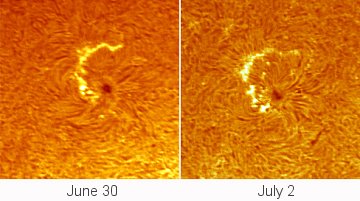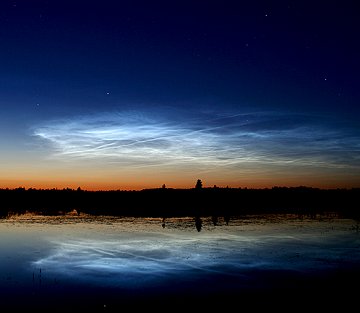 Where's Saturn? Is that a UFO--or the ISS? What's the name of that star? Get the answers from mySKY--a fun new astronomy helper from Meade. Where's Saturn? Is that a UFO--or the ISS? What's the name of that star? Get the answers from mySKY--a fun new astronomy helper from Meade. GENESIS II: Bigelow Aerospace has launched another inflatable satellite: Genesis II. Believe it or not, the 4.4-meter wide balloon is a prototype module for a space hotel. On July 1st, satellite observer Kevin Fetter photographed Genesis II gliding past the bright star Vega: video. "Genesis was about as bright as a 3rd magnitude star--easily visible to the unaided eye," says Fetter. Would you like a call when Genesis II flies over your hometown? Sign up for Spaceweather PHONE. SUNSPOT 961: At first glance, sunspot 961 looks featureless and bland. But an H-alpha filter tuned to the red glow of solar hydrogen reveals something quite different--a bright spiral emerging from the sunspot's dark core. This picture comes from C. LaCroix, R. Enriquez and John Stetson of South Portland, Maine: 
The spiral traces a ridge of north magnetic flux into the sunspot's south magnetic core. What makes the spiral so hot and bright? It may be a region where hot gas is bottled-up by magnetic forces--or maybe it is an arc of intense magnetic turbulence--or something else. Certainly, it is not entirely stable: Note the changes from June 30th to July 2nd. Amateur astronomers with solar telescopes should keep an eye on sunspot 961. more images: from Rogerio Marcon of Campinas - Brazil; from Mike Taormina of Palatine, Illinois; from Emiel Veldhuis of Zwolle, the Netherlands; from Mike Strieber of Las Vegas, NV; from Franck Charlier of Marines, Val d'Oise - France; from Cai-Uso Wohler of Bispingen, Germany; a pastel sketch from Erika Rix of Zanesville, Ohio; from Enrico Perissinotto of Premariacco (UD) Italy; from Britta Suhre of Dortmund, Germany. NOCTILUCENT NEPHELOCOCCYGIA: Look into a cloud and what do you see? A flying elephant? A mouse? A dragon? Finding shapes in clouds is called nephelococcygia (refs: #1, #2). Last night in Lithuania, photographer Donatas Tamonis conducted noctilucent nephelococcygia. "This bright noctilucent cloud reminded me of a giant squid," he says. (continued below) 
"Clouds often take various shapes that remind us of something. Noctilucent clouds are no exception." Browse the gallery and decide for yourself: 2007 Noctilucent Cloud Gallery
["Noctilucent Cloud"--the song] [Night-Sky Cameras] | 
